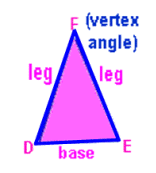| A | B |
|---|
What do we call a triangle with two congruent sides?,  | Isosceles |
What do we call the congruent sides of an isoscles triange?,  | legs |
What do we call the third side of an isosceles triangle?,  | base |
What do we call the angle opposite the base?,  | vertex angle |
What do we call the angles at the base?,  | base angles |
Theorem 4.1: The Isosceles Triangle Theorem. If two sides of a triangle are congruent, then the angles opposite those sides are....,  | congruent <A is congruent to <B |
Theorem 4.2: Converse of Isosceles Triangle Theorem: If two angles of a triangle are congruent, then the sides opposite the angles are...,  | congruent. |
Corollary 3 of Theorem 4.1: the bisector of the vertex angle of an isosceles triangle is the perpendicular bisector of the base. So, if side CD bisects side AB, then.....,  | side CD is perpendicular to side AB |
Corollary 1 of Theorem 4.1: If a triangle is equilateral, than the triangle is also....,  | equiangular |
Corollary 2 of theorem 4.1: An equilateral triangle has 3...,  | 60 degree angles. |
Corollary to theorem 4.2: an equiangular triangle is also...,  | equilateral |